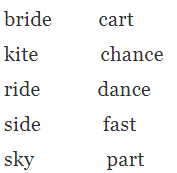NCERT Solutions for Class 1 English Marigold Unit 7 - A Kite
Page No 77:
Question 1: Learn New Words
A) Blow
B) Breeze
C) Chanced
D) Kite
E) Sit
Answer:
A) Blow: To send forth a current of air Example sentences:
1) Blow air into the balloon.
2) He asked me to blow the candles.
B) Breeze: A gentle wind Example sentences:
1) The flowers were flowing along with the breeze.
2) Breeze and music together makes me feel fresh.
C) Chanced: When you are not sure about something Example sentences:
1) I chanced to look at my mother dancing.
2) I chanced to solve the problem.
D) Kite: A light paper that is attached with a long string and flown in the wind Example sentences:
1) I enjoy flying kite with my friends.
2) We had a kite flying competition in school.
E) Sit: To be a position in which your bottom is resting on a chair, ground, etc. Example sentences:
1) I have already asked her to sit.
2) I wish I could sit on the clouds.
Page No 78:
Question 1:
- What does the child wish to be?
- What does the child wish to do with the breeze?
Answer:
- The child wishes to be a kite.
- The child wishes to ride upon the breeze and go whichever way he/she was chanced to blow by the breeze.
Question 2:
- What would you like to be?
- Imagine you are a bird in the sky. Describe what you will feel when you see a kite flying near you.
Answer:
- I would like to be a squirrel, as it runs very fast and is able to climb trees easily.
- If I were a bird, I would feel very excited to see a kite flying near me. I would follow the kite and try to catch it and tear it off with my beak.
Disclaimer: These are sample answers. Students are advised to write the answers based on their own experiences or observations.
Question 3: Do you know more words with these sounds?
Do you know more words with these sounds?
Answer:
- Yes, I know more words with these sounds. They are
 Disclaimer: The first part of the question is to be done by the students themselves. The answer to the second part of the question may vary from student to student.
Disclaimer: The first part of the question is to be done by the students themselves. The answer to the second part of the question may vary from student to student.
Question 4:
- What are different things that fly in the sky?
- If you had wings, where would you fly?
Answer:
- Birds, aeroplane, helicopters and bats fly in the sky.
- If I had wings, I would fly to London.
Disclaimer: These are sample answers. Students are advised to write the answers based on their own experiences or observations.
Question 5: Trace on the rain patterns.
Disclaimer: Kindly refer the textbook for the images.
Answer:
Disclaimer: Join the dotted lines to trace the rain patterns.
Page No 79:
Question 1: Use the picture clues to draw pictures of the day sky and night sky in the windows. Colour the pictures.
Disclaimer: Kindly refer the textbook for the images.
Answer:
Disclaimer: Such questions are made for increasig self creative skills and should be tried on your own. The students may colour the picture using the colours of their choice.
Question 2: You see them all in the sky.
Fill in the blanks by choosing words from the box.
 Disclaimer: Kindly refer the textbook for the images.
Disclaimer: Kindly refer the textbook for the images.
Answer:
FAQs on NCERT Solutions for Class 1 English Marigold Unit 7 - A Kite
| 1. What are the different types of kites? |  |
| 2. How do you fly a kite? |  |
| 3. What materials are kites made of? |  |
| 4. What is the history of kites? |  |
| 5. Can you make your own kite? |  |
















